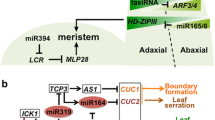Abstract
Small, 21–22 nucleotide long RNAs called microRNAs play an essential role in the spatial and temporal regulation of gene expression. They are often part of complex gene networks. By controlling the stability or translation of their target mRNAs they have an influence on many developmental pathways. Juvenile to adult transition, initiation of flowering or plant architecture and leaf morphology are examples of miRNA-regulated processes during plant development.
Similar content being viewed by others
Literatur
Voinnet O (2009) Origin, biosynthesis, and activity of plant microRNAs. Cell 136:669–687
Yu S, Cao L, Zhou C-M et al. (2013) Sugar is an endogenous cue for juvenile-to-adult phase transition in plants. ELife, doi: 10.7554/eLife.00269
Chuck GS, Tobias C, Sun L et al. (2011) Overexpression of the maize Corngrass1 microRNA prevents flowering, improves digestibility, and increases starch content of switchgrass. Proc Natl Acad Sci USA 108:17550–17555
Lauter N, Kampani A, Carlson S et al. (2005) microRNA172 down-regulates glossy15 to promote vegetative phase change in maize. Proc Natl Acad Sci USA 102:9412–9417
Yant L, Mathieu J, Dinh TT et al. (2010) Orchestration of the floral transition and floral development in Arabidopsis by the bifunctional transcription factor APETALA2. Plant Cell 22:2156–2170
Raman S, Greb T, Peaucelle A et al. (2008) Interplay of miR164, CUP-SHAPED COTYLEDON genes and LATERAL SUPPRESSOR controls axillary meristem formation in Arabidopsis thaliana. Plant J 55:65–76
Nikovics K, Blein T, Peaucelle A et al. (2006) The balance between the MIR164A and CUC2 genes controls leaf margin serration in Arabidopsis. Plant Cell 18:2929–2945
Yang C, Li D, Mao D et al. (2013) Overexpression of microRNA319 impacts leaf morphogenesis and leads to enhanced cold tolerance in rice (Oryza sativa L.). Plant Cell Environ, doi: 10.1111/pce.12130
Mecchia MA, Debernardi JM, Rodriguez RE et al. (2012) MicroRNA miR396 and RDR6 synergistically regulate leaf development. Mech Dev 130:2–13
Author information
Authors and Affiliations
Corresponding author
Additional information
Detlef Weigel Jahrgang 1961. 1986 Diplom in Biologie, Universität zu Köln. 1988 Promotion, Universität Tübingen. 1989–1993 Postdoktorand, California Institute of Technology, Pasadena, USA. 1993–2002 Assistant und Associate Professor am Salk Institute, La Jolla, CA, USA. Seit 2002 Direktor der Abteilung Molekularbiologie am Max-Planck-Institut für Entwicklungsbiologie, Tübingen.
Patricia Lang Jahrgang 1987. 2010 Master in Pflanzen- und Waldbiotechnologie, Ume Center, Umeät, Schweden. Seit 2012 Promotion, Max-Planck-Institut für Entwicklungsbiologie, Tübingen.
Rights and permissions
About this article
Cite this article
Weigel, D., Lang, P. Kontrolle der Pflanzenentwicklung durch MikroRNAs. Biospektrum 19, 622–624 (2013). https://doi.org/10.1007/s12268-013-0363-4
Published:
Issue Date:
DOI: https://doi.org/10.1007/s12268-013-0363-4




